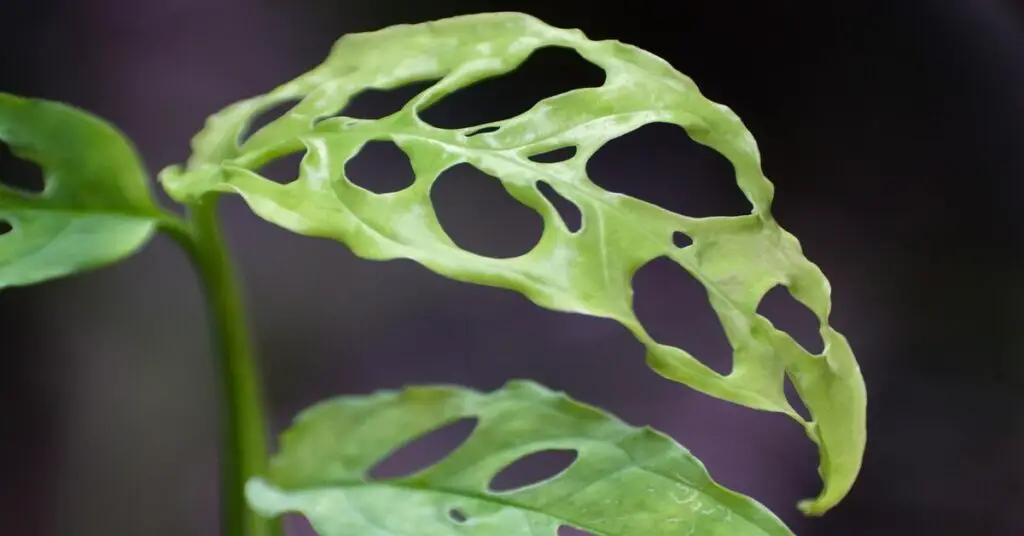Monstera obliqua is a rare hemiepiphyte with unique leaf fenestrations. There are many ‘forms’ of Monstera obliqua, each native to a specific geographical area. This article discusses the rarest form, Monstera obliqua Peru.
Madison 1977 notes that Monstera obliqua leaves can vary greatly by geographical region. The Peru form has up to 90 percent of the leaf area fenestrated. Making it the most desirable form for plant enthusiasts.
In its native habitat in Peru, Monstera obliqua produces 30 to 70 leaves per year. But otherwise, it grows very slowly, taking a month or more to produce a single leaf. It is a vining plant that can grow up a moss cover pole or cascade over a pot.
Monstera Obliqua Peru Care
Proper care of Monstera obliqua is critical. Since it grows slowly, recovering from damage will take a long time. Overwatering and unacceptable lighting conditions are two of the most common causes of unhealthy Monstera obliqua plants.
Monstera obliqua requires high humidity levels and well-draining soil to thrive. You must also fertilize it regularly and watch for insects and disease issues. Below are all the details you need to grow Monstera obliqua Peru successfully.
Soil
Use well-draining soil, such as an aroid mix, to prevent overwatering. Aroid mixes vary, but most consist of coco coir, perlite, orchid bark, potting soil, worm castings, and horticultural charcoal.
Another option is to use 100 percent sphagnum moss. But keep in mind it contains no nutrients for your Obliqua Peru.
Watering
Don’t overwater your Monstera obliqua Peru. Only water when the soil is dry. Do not use saucers under the plant’s pot, as this will not allow the soil to drain properly and may lead to root issues.
Lighting
The obliqua Peruvian form does not tolerate direct sunlight well. Bright, indirect light works best. The University of Georgia recommends you provide 75 to 200 footcandles (ft-c) of light for Monstera obliqua.
Humidity & Temperature
Being native to the tropics, Monstera obliqua Peru needs high humidity and warm temperatures. Humidity should be kept around 80 percent. This is achievable by growing your plant in a terrarium or plastic box. The ideal temperature is 75 to 80 degrees Fahrenheit.
Fertilizing
Fertilize your Monstera obliqua Peru monthly. This is especially important when using sphagnum moss as your soil. A liquid fertilizer with a nitrogen, phosphorus, and potassium ratio of 20-20-20 works well.
Propagation
Propagation of Monstera obliqua Peru is difficult and slow. Node cuttings from Monstera obliqua Peru runners are likely the most cost-effective and easiest to obtain for propagation. Ideally, your cutting should have 2 to 4 nodes.
Place the cutting on moist sphagnum moss in a container with a lid to increase humidity. Please place it in a well-lit area and open the container daily for fresh air. A heating pad under the container to keep it warm can help.
Patience is key! It can take four months or longer to see leaves grow.
Diseases & Pests
Whiteflies, mealybugs, spider mites, and thrips can all feed on Monstera obliqua Peru. And can be controlled with insecticides. Diseases that can impact it include anthracnose, powdery mildew, mosaic virus, leaf-spot disease, root rot, rust, and southern blight. Prevent disease by providing proper care to keep your plant healthy. And quarantine any new plants you acquire.
Toxicity
The calcium oxalate in Monstera obliqua Peru is toxic to pets and humans. It will irritate the mouth, esophagus, stomach, decreased appetite, and vomiting.

